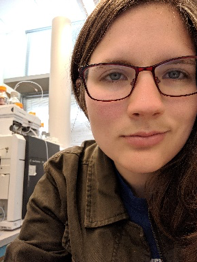Org. Synth. 2022, 99, 79-91
DOI: 10.15227/orgsyn.099.0079
Preparation of a Donor-Acceptor Stenhouse Adduct (DASA): 5-((2Z,4E)-5-(Diethylamino)-2-hydroxypenta-2,4-dien-1-ylidene)-2,2-dimethyl-1,3-dioxane-4,6-dione
Submitted by Friedrich Stricker, Julie Peterson, and Javier Read de Alaniz*
1Checked by Feng Peng and Kevin Campos
1. Procedure (Note 1)
A.
5-(Furan-2-ylmethylene)-2,2-dimethyl-1,3-dioxane-4,6-dione (1). An oven-dried 500 mL round-bottomed flask equipped with an egg-shaped, teflon-coated magnetic stir bar (3 cm x 1.5 cm) is connected to an air condensor that is capped with a rubber septum, which is fitted with a needle outlet open to the atmosphere.
Meldrum's acid (15.1 g, 105 mmol, 1.05 equiv) (
Note 2) is charged into this flask. Water (300 mL) is added to the flask which is heated in an oil bath to 60 °C.
Furfural (9.6 g, 8.2 mL, 100 mmol, 1.00 equiv) (
Note 3) is added, and the reaction mixture is stirred at 60 °C for 2 h (Figure 1) . The heterogenous solution first turns yellow upon addition of
furfural while a yellow precipitate forms before turning black with additional yellow precipitate forming.
Figure 1. Reaction vessel after heating at 60 °C for A) 0.5 h, and B) 2 h (photo provided by checker)
After 2 h, the solution is left to cool to room temperature and then filtered through a Büchner funnel (6.5 cm diameter) equipped with a filter into a 500 mL sidearm flask. The off-colored yellow solid is then dissolved in 100 mL of
ethyl acetate:hexanes (2:8) (
Note 4). The solution is filtered through a vacuum filtration adapter (10 cm length x 3 cm diameter) plugged with cotton and charged with silica gel (12 g, SiO
2) using
ethyl acetate:hexanes (2:8) as the mobile phase. The yellow band of material is collected from the silica gel column (Figure 2) and concentrated at room temperature by rotary evaporation (20 mmHg) and then at 0.05 mmHg to provide the product as a yellow solid (19.8 g, 88 mmol, 88 %) (Notes
5,
6 and
7).
Figure 2. Filtration of 1 through silica gel (Photo provided by submitter)
B.
5-((2Z,4E)-5-(Diethylamino)-2-hydroxypenta-2,4-dien-1-ylidene)-2,2-dimethyl-1,3-dioxane-4,6-dione (2). An oven-dried 100 mL round-bottomed flask equipped with an egg-shaped, Teflon-coated magnetic stir bar (3 cm x 1.5 cm) is capped with a rubber septum. Compound
1 (10 g, 45.0 mmol, 1.0 equiv) is charged into the flask, and
THF (10 mL) (
Note 8) is added as the solvent. The rubber septum is fitted with a needle outlet open to the atmosphere and the mixture is stirred in a cold water bath (
Note 9) and
diethylamine (3.3 g, 4.7 mL, 45.0 mmol, 1.0 equiv) (
Note 10) is added dropwise using a syringe over 20 min.
Figure 3. Addition of diethylamine to 1 in THF (photo provided by submitter)
Upon addition of diethylamine the solution turns from dark yellow to bright pink and then dark violet (Figure 3). After complete addition of diethylamine, the solution is stirred at 22 °C for 20 min. Diethyl ether (20 mL) is added and the solution is filtered over a Büchner funnel (6.5 cm diameter) equipped with a filter at room temperature. The solid is washed with diethyl ether (2 x 10 mL) and dried at 0.05 mmHg to provide the product (2) as a violet solid (9.7 g, 32.8 mmol, 73 %) (Notes 11, 12, 13 and 14).
2. Notes
1. Prior to performing each reaction, a thorough hazard analysis and risk assessment should be carried out with regard to each chemical substance and experimental operation on the scale planned and in the context of the laboratory where the procedures will be carried out. Guidelines for carrying out risk assessments and for analyzing the hazards associated with chemicals can be found in references such as Chapter 4 of "Prudent Practices in the Laboratory" (The National Academies Press, Washington, D.C., 2011; the full text can be accessed free of charge at
https://www.nap.edu/catalog/12654/prudent-practices-in-the-laboratory-handling-and-management-of-chemical). See also "Identifying and Evaluating Hazards in Research Laboratories" (American Chemical Society, 2015) which is available via the associated website "Hazard Assessment in Research Laboratories" at
https://www.acs.org/content/acs/en/about/governance/committees/chemicalsafety/hazard-assessment.html. In the case of this procedure, the risk assessment should include (but not necessarily be limited to) an evaluation of the potential hazards associated with
Meldrum's acid,
furfural,
tetrahydrofuran (
THF),
diethylamine,
diethyl ether, hexanes,
ethyl acetate,
CDCl3, and
1,3,5-trimethoxybenzene.
2.
Meldrum's acid (98%) was purchased from Acros Organics and used without further purification.
3. The checkers used
furfural from Aldrich without purification, which provided similar yield as distilled
furfural used by submitters. The submitters distilled
furfural according to
Organic Syntheses procedure.
2 The distilled
furfural can be stored in the freezer for up to 2 months.
4. The solid can be easily solubilized by addition of
ethyl acetate first and after the solid is fully dissolved subsequent addition of the appropriate amount of hexanes. Additional solvent (
ethyl acetate:hexanes 2:8) can also be added to achieve full solubility.
5. The product (
1) has been characterized as follows: mp 91-93 °C;
1H NMR
pdf (500 MHz,
CDCl3) d: 8.47 (d,
J = 3.8 Hz, 1H), 8.36 (s, 1H), 7.87 - 7.83 (m, 1H), 6.76 (d,
J = 3.0 Hz, 1H), 1.78 (s, 6H).
13C NMR
pdf (126 MHz,
CDCl3) d: 163.2, 160.2, 150.4, 150.2, 141.2, 128.1, 115.2, 107.6, 104.5, 27.6. FTIR (cm
-1): 1741.6, 1701.2, 1580.2, 1454.7, 1404.6, 1360.4, 1275.2, 1200.1, 1168.6, 1147.4, 1094.9, 1027.2, 942.8, 780.9. [M + Na] calcd for C
11H
10O
5Na: 245.0420. Found: 245.0422.
6. The purity of
1 was determined to be >99 %wt. by quantitative
1H NMR
pdf spectroscopy in
CDCl3 using 29.2 mg of
1 and 17.1 mg of
1,3,5-trimethoxybenzene as internal standard (pulse delay (D1) = 10 s).
7. A second reaction on identical scale provided 19.1 g (86%) of the product with identical purity.
8.
Tetrahydrofuran (stabilized with 0.025% BHT) was obtained from Fisher Scientific and used without further purification.
9. Temperature is approximately 10 °C.
10.
Diethylamine (Reagent Grade) was purchased from Fisher Scientific and used without further purification. The reaction is exothermic and an addition time of 20 min is recommended.
11. The product (
2) has been characterized as follows: mp 130-132 °C;
1H NMR
pdf (500 MHz,
CDCl3) d: 11.42 (s, 1H), 7.27-7.19 (m, 1H), 7.09 (d,
J = 14.4 Hz, 1H), 6.72 (d,
J = 12.4 Hz, 1H), 6.06 (t,
J = 12.4 Hz, 1H), 3.50 (dd,
J = 7.1, 2.9 Hz, 4H), 1.72 (s, 6H), 1.33 (t,
J = 7.1 Hz, 3H), 1.33 (t,
J = 7.1 Hz, 3H).
13C NMR
pdf (126 MHz,
CDCl3) d: 167.1, 165.2, 156.6, 151.0, 144.9, 139.4, 103.4, 102.0, 90.8, 51.8, 44.0, 26.7, 14.5, 12.3. FTIR (cm
-1): 2987.4, 1713.7, 1676.9, 1631.9, 1593.8, 1570.4, 1507.5, 1461.2, 1412.9, 1365.6, 1337.6, 1257.8, 1170.7, 1121.0, 998.0, 887.5, 734.5 cm
-1. [M - H] calcd for C
15H
21NO
5: 294.1342. Found: 294.1341.
12. Trace amount of triene
EZZ isomer was usually observed (representative
1H NMR resonances observed at 12.1, 9.1, and 6.5 ppm) due to the water from NMR solvents. For details, see
J. Am. Chem. Soc.
2019,
141 (18), 7376-7384.
313. The purity of
2 was determined to be >97 %wt. by quantitative
1H NMR
pdf spectroscopy in
CDCl3 using 26.7 mg of
2 and 12.1 mg of
1,3,5-trimethoxybenzene as internal standard (pulse delay (D1) = 10 s).
14. A second reaction on identical scale provided 9.5 g (71%) of the same product with identical purity.
Working with Hazardous Chemicals
The procedures in
Organic Syntheses are intended for use only by persons with proper training in experimental organic chemistry. All hazardous materials should be handled using the standard procedures for work with chemicals described in references such as "Prudent Practices in the Laboratory" (The National Academies Press, Washington, D.C., 2011; the full text can be accessed free of charge at
http://www.nap.edu/catalog.php?record_id=12654). All chemical waste should be disposed of in accordance with local regulations. For general guidelines for the management of chemical waste, see Chapter 8 of Prudent Practices.
In some articles in Organic Syntheses, chemical-specific hazards are highlighted in red "Caution Notes" within a procedure. It is important to recognize that the absence of a caution note does not imply that no significant hazards are associated with the chemicals involved in that procedure. Prior to performing a reaction, a thorough risk assessment should be carried out that includes a review of the potential hazards associated with each chemical and experimental operation on the scale that is planned for the procedure. Guidelines for carrying out a risk assessment and for analyzing the hazards associated with chemicals can be found in Chapter 4 of Prudent Practices.
The procedures described in Organic Syntheses are provided as published and are conducted at one's own risk. Organic Syntheses, Inc., its Editors, and its Board of Directors do not warrant or guarantee the safety of individuals using these procedures and hereby disclaim any liability for any injuries or damages claimed to have resulted from or related in any way to the procedures herein.
3. Discussion
Donor-acceptor Stenhouse adducts (DASAs) are an emerging class of negatively photochromic photoswitches discovered by our group in 2014. Since their discovery, DASA's promising properties - visible light activation, high extinction coefficient, negative photochromicity, large volume and polarity change - have enabled a number of applications including drug release,
4 phase transfer,
5 programmable adhesion,
6 photothermally controlled flow,
7 and amine and heat sensing.
8,9,10
DASAs originate from a lecture by J. Stenhouse in 1850 reporting a red dye.
11,12 In this lecture, Stenhouse disclosed that skin, paper, white velvet, canvas or cotton fabric treated with
furfural slowly changes to roseate with the addition of a few drops of aniline (Scheme 1). These initially reported Stenhouse Salts were later discovered to be photochromic in nature by Honda.
13 The product of the visible light driven reaction was not named. However, retrospective mechanistic analysis suggests a colorless 4,5-diaminocyclopentenone adduct as the product. These 4,5-disubstituted cyclopentenone adducts, which our group was investigating at the time, led to our serendipitous discovery of DASA based photoswitches. Inspired by the work of Piancatelli on the acid catalyzed rearrangement of furylcarbinols, we had developed an efficient aza-Piancatelli rearrangement of furylcarbinols using aniline based nucleophiles in 2010 (Scheme 1).
14,15,16,17,18 To expand the scope of this new methodology to aliphatic amines, we turned our attention to a preliminary study by Safar and coworkers on the rearrangement of activated furans with cyclic secondary aliphatic amines (i.e., DASA) which we found also to be catalyzed by light.
19 While Stenhouse salts proceeded through imine/iminium activation, the electron withdrawing character of
Meldrum's acids provides the activation of the furan ring for the ring opening reaction to generate DASAs (Scheme 1).
11,20
Scheme 1. Modular approach towards Stenhouse Salts and donor-acceptor Stenhouse adducts (DASA)
DASA-based photochromes all share a triene backbone bearing a hydroxy group in the C2-position- provided by the
furfural building block - an electron withdrawing carbon acid acceptor and an electron donating amine at the terminal end as general architecture.
11,21 Prior to the DASA formation,
furfural is activated via a Knoevenagel condensation with a carbon acid. Subsequently, a secondary amine nucleophile initiates a ring opening reaction of the activated furan core, resulting in the visible light responsive DASA photochrome in a modular and straightforward two-step synthesis.
Originally DASA photochromes were based on dialkylamine donors and acceptors derived from either
Meldrum's acid or barbituric acid.
11,20 These first generation photochromes were limited to chlorinated and apolar solvents with limited wavelength tunabilty. In 2016, Read de Alaniz
22 and Beves
23 independently introduced a second-generation DASA which employed weaker electron donating arylamines (
N-methylaniline and indoline derivatives) with improved wavelength tunability and expanded DASA solvent compatibility to more polar solvents such as acetonitrile. Although the weakly-donating amines provided improved photoswitching properties, they also introduced several drawbacks, most notably compromised thermodynamic equilibria meaning high amounts of closed form in the dark.
22 As a result, a third generation DASA was developed in 2018 which introduced new classes of more electron-withdrawing acceptor moieties to overcome drawbacks while maintaining the improvements of the second generation (Scheme 2).
24
Scheme 2. Structural development of donor-acceptor Stenhouse adducts
The complex photoswitching mechanism has been studied by Feringa in a number of papers investigating both the actinic and the subsequent thermal steps (Scheme 3).
3,25,26,27,28 The actinic step consists of an
E-Z isomerization around the α-bond next to the hydroxy group (
A to
A′). Subsequently a thermal bond rotation (
A′ to
A′′) sets up a rate determining 4 π-electrocyclization forming the first colorless closed form isomer (
A′′ to
B). The closed form then undergoes an orbital inversion on the amine (
B to
B′) followed by a bond rotation and/or a proton transfer (
B′ to
B'' or
C;
B'' to
B''' or
C) resulting in either a neutral (
C) or zwitterionic closed form (
B''').
3
Scheme 3. Proposed photoswitching mechanism of donor-acceptor Stenhouse adducts
Appendix
Chemical Abstracts Nomenclature (Registry Number)
Meldrum's Acid: 2,2-Dimethyl-1,3-dioxane-4,6-dione; (2033-24-1)
Furfural: 2-Furancarboxaldehyde; (98-01-1)
Ethyl Acetate: Acetic acid ethyl ester; (141-78-6)
Diethylamine: N-ethylethanamine; (109-89-7)
THF: Tetrahydrofuran; (109-99-9)

|
Friedrich Stricker earned his B. Sc. and M. Sc. in biomedical chemistry at the Johannes Gutenberg-University, Mainz in 2015 and 2018 respectively conducting research on supramolecular polymers under Prof. Besenius. In 2018 he started his Ph.D. studies at the University of California, Santa Barbara under Prof. Read de Alaniz studying photochromic molecules and materials. |

|
Julie Peterson received her B. A. in chemistry from University of Kansas in 2014 where she did undergraduate research with Prof. Richard Givens. She obtained her Ph. D. in 2020 from Iowa State University under the guidance of Prof. Arthur Winter, studying photoactive molecules. She joined UCSB as an Elings Postdoctoral Fellow in 2020 to work in Prof. Read de Alaniz's group, where she is currently working on designing new photochromic compounds. |

|
Javier Read de Alaniz joined the Department of Chemistry and Biochemistry at University of California at Santa Barbara in 2009 as an Assistant Professor. He received his B. S. degree from Fort Lewis College (Durango, Colorado) in 1999 where he conducted undergraduate research under the direction of Professor William R. Bartlett. He obtained his Ph. D. in 2006 under the supervision of Professor Tomislav Rovis at Colorado State University with a research focus on asymmetric catalysis. Javier then moved to California, where he worked in the area of total synthesis with Professor Larry E. Overman at the University of California, Irvine. |

|
Feng Peng joined the Process Research Department of Merck & Co., Inc. in 2012. His research focuses on using state-of-art organic chemistry to address critical problems in drug development. He received his B. S. degree from Beijing Normal University. He obtained his M.S. under the supervision of Professor Dennis Hall at University of Alberta with a research focus on Boron Chemistry. Feng then moved to New York City, where he obtained Ph. D. in the area of total synthesis (maoecrystal V) with Professor Samuel Danishefsky at Columbia University. |
Copyright © 1921-, Organic Syntheses, Inc. All Rights Reserved